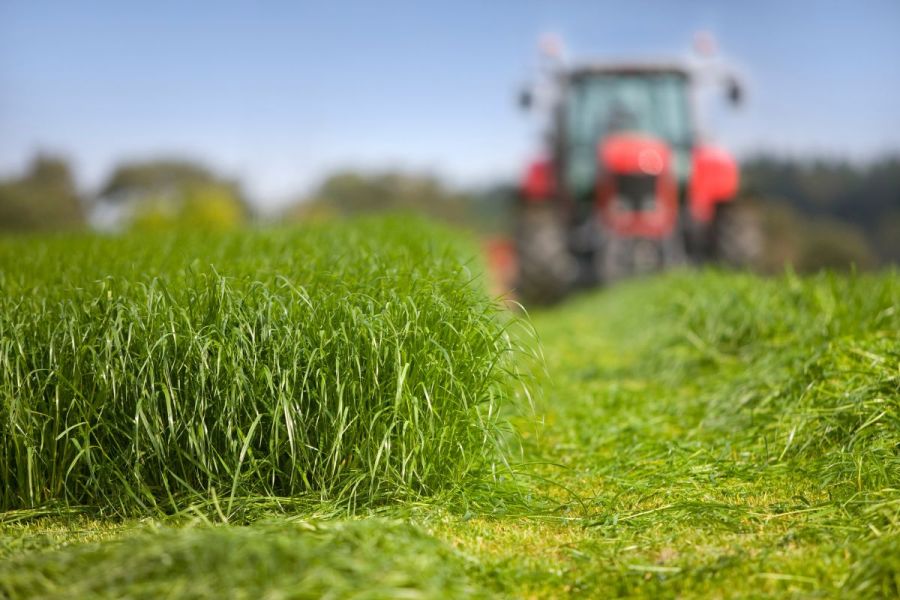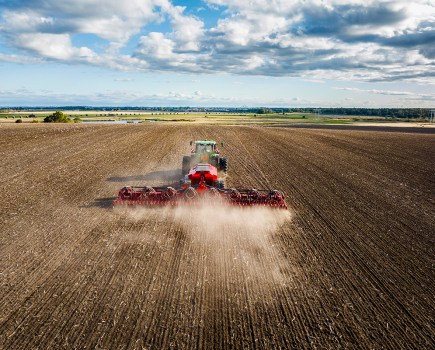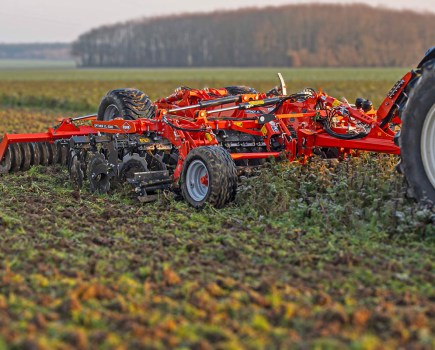Growing demand for energy maize, supported by its appeal as a non-cereal alternative break crop, has seen a reverse in declining demand for self-propelled forage harvesters from national dairy herd contraction. But how does a typical buyer choose between the makes on the market? CPM finds out a contractor’s viewpoint.
“The wider opening and more aggressive intake of the new feedrolls makes a big difference.”
By Martin Rickatson
Back-up. Support. Service. Different words for the same single feature that Steve Bond cites as the key reason for staying with the same make of self-propelled forage harvester since he started contracting thirty years ago.
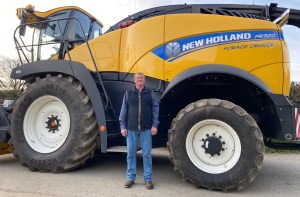
Devon contractor Steve Bond chose to stay with New Holland when replacing his previous FR700 forager, trading up to a new FR920.
While specification, performance and machine reliability have shaped his choices, prior dealer and manufacturer back-up have cemented the deal each time over the past few decades when he has come to renew his forager.
His business is based not in the arable areas of the east, where foragers are now probably most commonly used to chop AD maize rather than livestock forage, but in the dairy heartland of the south-west, at Woodacott Cross, near Holsworthy, Devon. Begun out of the family dairy farm, today the operation centres on the family’s blocks of owned and rented land, totalling around 304ha (750ac), in addition to which Steve and his six-strong workforce carry out other individual contract tasks.
“Most of our arable work is based around wheat and maize, the latter being grown largely for local dairy farm customers,” explains Steve.
“This is mainly a heavy land area, so when conditions are right for any operation, be that cultivations, drilling or maize harvesting, we need the capacity to get jobs done in good weather windows before the conditions change and the soils get too wet to work with.”
When he began contract forage harvesting in the early 1980s, maize was still relatively new to the UK and its area relatively small. Self-propelled foragers were fresh to the market, and chopping via a two- or three-row header on a trailed machine was not uncommon. It was with this type of machine that Steve began harvesting maize to make silage for local dairy farms.
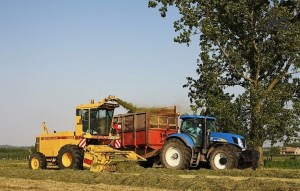
Steve’s early experiences with New Holland foragers included 1900, 2205 and 2305 models, plus the FX series that succeeded them, before moving on to FRs.
“After operating a number of different trailed makes, demand was such that it warranted investing in my first self-propelled machine. A good relationship with my local New Holland dealer was a key influence on my choice at the time, leading to a deal to buy a New Holland 1900.
“As the grass and maize workload increased, we had the staff and the demand to warrant a second machine. While the New Holland had worked well, I was made a good offer by our local John Deere dealer, who is also fairly close by, and so we ran a John Deere alongside the first New Holland for a time during the early 1980s.”
As the number of local dairy units began to diminish during the next few years, and new forage harvester designs became capable of greater capacities, it was decided to return to a single machine. While, by now, he had plenty of experience of two different makes, Steve at this point decided to settle on New Holland.
“We run a mixed fleet of equipment, and our combine and most of our tractors are of different makes, although we do run one New Holland tractor, a T7.260. But we’ve a good relationship with the main Holsworthy branch of Andrew Symons, our local New Holland dealer, and have always received good parts and service back-up, while the service engineers’ forager product knowledge is something I have always valued. Those things help make a sale.”
That meant that while the John Deere machine was sold, the 250hp 1900 made way for a 335hp 2205, which itself later was replaced with a 350hp 2305, the business seeking more power each time as new models became available.
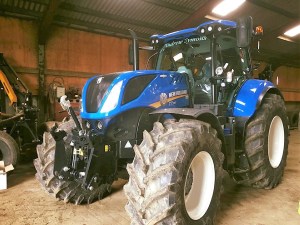
The business runs a mixed tractor fleet but a good relationship with the New Holland dealer, who has supplied a series of NH foragers, has also led to the recent purchased of this T7.260.
“In the early 2000s, we moved to the new FX models, with an FX375, and then the first of the current-type FR design. Since then we have had three further FRs,” explains Steve.
“I do look at what else is available – we have prior experience with John Deere and have tried a Krone. But as we are familiar with the product and have a good dealer nearby, it has consistently made sense to stay with what we know, particularly as our main forager operator has also preferred the New Holland when trying other makes. That’s led us to the point where we are now on our eighth New Holland forager.”
Forage harvesting is one element of a range of services offered by the business, with other focus areas including slurry application with umbilical-equipped tankers, muck spreading and crop establishment, mostly within a 25-mile radius. The workload is helped by having a spread of customers up to the north Devon coast, where land tends to be lighter and earlier, but being close to the coast means machinery capacity is crucial to making the most of good conditions, particularly on the heavier land closer to home.
“That’s the main reason we’ve kept upgrading to more capacity each time we change a forager and a larger model has become available. Spare capacity is invaluable in helping get ahead on a job, and that justifies the extra investment. Where needed, we can put another loader and a couple more trailers onto the job to keep up.”
Now with two seasons under its belt, his current harvester is New Holland’s FR920 ‘Forage Cruiser’ flagship, introduced in late 2017 for the following season and superseding the old 824hp FR850 as the New Holland range-topper. The machine heads a line of five models starting at 476hp.
While the next model down features a 15.9-litre powerplant, the FR920 makes exclusive use of FPT Industrial’s then-new V20 engine, with eight V-arranged cylinders and a 20-litre displacement. Its maximum 911hp output is delivered across a 1600-1800rpm engine speed band, with maximum fuel efficiency across the 1600-1900rpm range. Maximum torque is 4095Nm, with a 44% torque rise from 2100 down to 1600rpm as the engine comes under increased load. New Holland and FPT claim the engine’s power curve has been mapped specifically to match forage harvester demands and the challenges of reacting fast to changing load.
To match the new engine’s higher power output, New Holland also introduced a new heavy-duty direct driveline with reinforced and upgraded components. This incorporates heavy-duty axles and a meaty 4WD system, claimed to increase the maximum torque transferred to the wheels by 60% over the standard arrangement on the FR850 former flagship.
Steering axle support was also reinforced, and maximum tyre size capabilities uprated. Other features will be familiar to those who know New Holland tractors, such as Terralock 4WD management, which dis/engages power to the rear axle according to the steering angle to minimise soil movement on the headlands.
With more power and an uprated driveline, the next revision was a reworked feeding system to make use of those upgrades. Intake area was upped by 12.5% with intake roll movement increased to allow the machine to ingest more crop at a faster pace. For maize, a new 9m row-independent header equipped with six large-diameter drums was introduced, with a fast double-folding function.
Also new were the DuraCracker and DuraShredder heavy-duty crop processing systems, offered as alternatives to the standard crop processing rolls. The former features reinforced frames and drives said to enhance kernel-cracking uniformity in maize, while the DuraShredder’s processing rolls incorporate additional spirals for more intensive processing of the green material as well as the cob. Meanwhile, established carried-over features included New Holland’s HydroLoc system, which maintains chop length independently of throughput and crop type, and ActiveLoc, which automatically adapts chop lengths to moisture content to enhance consolidation in the clamp.
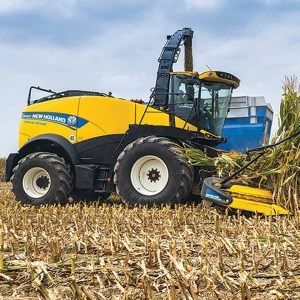
At 911hp, investment in an FR920 marked a significant step up from the previous 685hp FR700, with the additional power providing potential extra capacity to get through jobs faster.
At 911hp, investment in an FR920 marked a significant step up from Steve’s previous 685hp FR700, but it was not only the additional power and potential extra capacity that appealed.
“We’re making silage right through the summer and autumn, with customers for grass, wholecrop and maize, the latter all for dairy and beef herds. A with our workload increasing, the sums made sense when it came to upgrading to benefit from more daily output and capacity.
“But there was also the attraction of the more heavily-built components in the biggest model, plus the use of Hardox steel all the way through the key wearing parts, including the drum, blower, chute and spout. On top of this, new machine investment means new warranty coverage, meaning I know what the machine will cost to run for the next five years or 3000 hours, and I’m covered for any unexpected repairs to key components.”
For grass work, the machine is equipped with a 3.0m New Holland pick-up. With five tine bars, it’s reckoned to do a good job of lifting swaths from the business’s Krone 10m triple mower, Claas 13m tedder and Krone four-rotor/14m rake team.
“We retained our previous Kemper maize header and New Holland wholecrop head. Because we aren’t working with AD maize crops, we don’t need a very fine chop so the machine was ordered with the standard 2×10 blade chopping cylinder.”
Crop is fed into this by the ‘High Performance’ feedroll module that was introduced as standard equipment on the FR920, and this is rated for the smoother intake and greater output it brings from the bigger channel and the wider movement between the two intake rollers.
“The wider opening and more aggressive intake of the new feedrolls makes a big difference,” reckons Steve.
“Having them fitted as standard is a big plus on this machine – they really help to make use of the available power and push through the material to keep the chopping unit working at its capacity. In heavy grass crops the difference is especially noticeable.
“Because we don’t work with any AD maize, I opted for the 20-blade drum, which works fine for what our customers are seeking in both grass and maize. The bigger, heavier kernel processor works well in maize, and also in wholecrop where we also set it to bruise the grains.”
The machine was specified with the largest footprint tyres possible, a 710/70 R42 size that provides a long footprint.
“Early in the grass silage season some of the ground around here can be a bit soft, while we also have some fairly hilly land. Conditions can again be a bit on the softer side during maize harvest, depending on how wet the autumn has been, and these do a good job of putting more rubber on the ground to help in these circumstances. The machine is still almost 11ft (3.3m) wide on them and with our narrow roads, movement can sometimes be challenging.”
The trade-off with greater engine capacity and machine output can be reduced fuel economy, but Steve rates consumption as about what he expected.
“It’s a much bigger displacement engine than the one in our previous FR700, so is less pushed and under less stress. It seems to work well in combination with the transmission and the chopper and blower units, and has plenty of power for our hills.”
To support the FR920, the business runs 20t-capacity Ktwo ejector trailers, backed by hired-in tractor/trailer combinations for longer runs.
“Our longest haul would be maybe 8-10 miles on maize work, so we’re not moving too far from field to clamp. I don’t like to run too many trailers, as that can lead to things getting complicated on the road, but generally we seem to have worked things out in a way that keeps the forager moving and minimises any incidences of waiting for trailers. A JCB 418S Farm Master loading shovel with 4.8m push-off fork takes care of material coming into the clamp but is often supported by a tractor and compactor to ensure good consolidation in situations with nearby fields when trailer loads are coming in rapidly.
“It doesn’t look radically different on the outside, but in terms of comfort – particularly from a noise point of view – capacity and efficiency, the new series machine is a big step up from the old.”
This article was taken from the latest issue of CPM. Read the article in full here.
For more articles like this, subscribe here.
Sign up for Crop Production Magazine’s FREE e-newsletter here.

